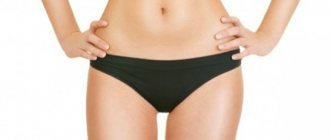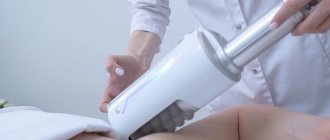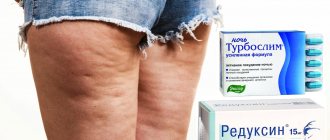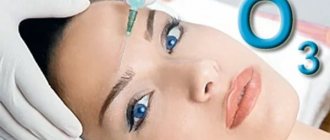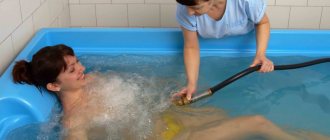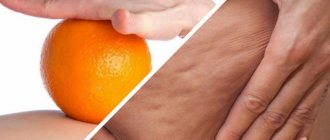Fat deposits are one of the most serious problems of modern man, along with excess weight and cellulite. Excess fat on the chin, abdomen, back, arms, hips, and knees can also appear in people of normal weight. It is very difficult to get rid of them on your own, even with diet and fitness.
Until recently, the most effective way to combat fat deposits was liposuction. But, as you know, any operation is a serious stress for the body. In addition, after surgery, quite a long rehabilitation is required. Therefore, liposuction is not suitable for everyone.
Fortunately, with the advent of body mesotherapy, many women and men were able to realize their dream of a beautiful and harmonious figure.
Body mesotherapy involves intradermal administration of various active substances. It is necessary to understand that this is not a way to quickly lose weight and get rid of extra pounds, but a course of procedures that improve the aesthetics of the body through the local elimination of fat deposits in problem areas. It is also the correction of various skin defects that cause discomfort in patients.
Indications for the procedure
The main goal of mesotherapy for cellulite is to get rid of fat accumulation and the “orange peel” effect, activate blood flow in the capillaries and eliminate stagnant processes under the skin.
Indications for mesotherapy are:
- decreased elasticity and firmness of the skin;
- flabbiness, decreased tone;
- the presence of swelling or subcutaneous nodes;
- painful feelings when pressing on the skin;
- unevenness of the skin surface, producing an “orange peel” effect;
- the presence of capillary stars and an expanded vascular pattern;
- pallor and lifelessness of the skin.
Mesotherapy is most effective at stages 2 and 3 of cellulite development. It actively acts on those areas of the skin where it is not possible to correct imperfections with wraps or massage. At stage 4, when large painful nodes appear, long-term complex treatment is indicated.
For cellulite, mesotherapy can be carried out in various ways: injection, hardware, fractional (mesoscooter).
Contraindications
The procedure is not recommended for patients in the following cases:
- vascular diseases;
- renal or liver failure;
- the presence of extensive wounds, burns or other damage to the skin;
- colds in the acute stage;
- mental disorders;
- the presence of malignant tumors;
- problems with blood clotting.
Mesotherapy sessions are not carried out during pregnancy, in case of individual sensitivity to the drugs used during the procedure. Mesotherapy sessions should not be performed during menstruation or a few days before their onset, when a woman’s pain threshold increases.
What drugs are used
There are two groups of anti-aging “cocktails” that are used in mesotherapy.
Homeopathic remedies are based on extracts and extracts of natural products, saturate the skin with vitamins and beneficial minerals, and restore healthy skin structure.
Alopathic (synthetic) “cocktails” stimulate collagen synthesis, improve blood circulation, strengthen the walls of blood vessels and eliminate swelling.
Injection solutions also include active substances:
- L-carnitine – breaks down fat deposits;
- lipolytics – normalize blood circulation, accelerate the breakdown of fat cells, normalize lipid metabolism;
- collagen – provides skin firmness and elasticity;
- antioxidants – remove waste and toxins from the body;
- hyaluronic acid – restores damaged tissue;
- plant extracts and vitamins - saturate, nourish the skin, and provide its hydration.
Typically, during one course, experts recommend using several types of “cocktails”. At the first stage, these can be injections with fat-burning active substances, then agents are used to activate blood circulation and metabolism, as well as components that improve the elasticity and tone of the skin.
The task of meso-cocktails is not only to eliminate the signs of cellulite, but also to prevent the occurrence of similar phenomena in the future.
The drugs used in mesotherapy are non-toxic and safe, so they do not put much strain on the body.
What is mesotherapy?
Mesotherapy is a technique for introducing microdoses of beneficial substances into the skin and subcutaneous fat that have a therapeutic effect on problem areas. Preparations that are used for mesotherapy are called “meso-cocktails”. They contain trace elements, vitamins and minerals, plant extracts, organic acids and other medicinal substances. The composition of the cocktail is selected by a cosmetologist personally for each patient, depending on the type and intensity of skin problems, and the individual characteristics of the client.
Mesotherapy allows you to restore microcirculation, normalize venous blood flow and lymph drainage, and achieve smooth and tightened skin without bumps and depressions. Medicinal substances stimulate the production of elastin and collagen, accelerate metabolism in the skin, and also promote weight loss in the areas where mesotherapy is administered.
How does the session work?
At the preparatory stage, the cosmetologist examines problem areas, determines the stage of cellulite development and decides on the number of sessions required. Before the procedure, you need to make sure that there are no contraindications and no risk of allergic reactions in the patient.
During the session, the patient lies on the couch. Areas requiring corrective intervention are treated with an antiseptic (2% chlorhexedine). Then the cosmetologist uses a thin needle (13*0.3) to inject active substances under the skin. The number of injections depends on the severity of cellulite and the extent of the problem area.
During the procedure, the woman experiences pain, which can be reduced by using a gun instead of a syringe. If the patient has a low pain threshold, a hardware method of drug administration may be recommended.
At the final stage, puncture marks are treated with an antiseptic. The duration of the procedure is about an hour, the frequency of its repetition is 1-2 times a week. Immediately after the session, the patient should be monitored for 20-30 minutes to eliminate the risk of side effects.
An alternative to the above methods is to apply the drug using a mesoscooter. It is a special roller that is convenient to use even at home. The fractional method of mesotherapy for cellulite is effective in the first stages of development of a cosmetic defect.
How is body mesotherapy performed?
Figure correction using mesotherapy works in the same way as other types of mesotherapy. The difference is in the ingredients of the cocktail. To eliminate cellulite, lipolytic injections are used. With their help, blood circulation improves, swelling in problem areas and lymph stagnation are removed.
Reviews about body mesotherapy left on the Internet by fans of this technique indicate that for the best effect, body mesotherapy is best combined with other figure correction procedures, such as acupuncture, massage, body wraps, etc.
Body mesotherapy. Photos before and after the procedure
1
Intralipotherapy (Aqualyx technology)
2 Intralipotherapy (Aqualyx technology)
3 Intralipotherapy (Aqualyx technology)
1 Intralipotherapy (Aqualyx technology)
2 Intralipotherapy (Aqualyx technology)
3 Intralipotherapy (Aqualyx technology)
Result of the sessions
A mesotherapy session for cellulite can achieve the following results:
- the fat layer is reduced;
- skin tone increases, its firmness and elasticity improves;
- the “orange peel” effect, bumps and folds are eliminated;
- body contours improve;
- swelling and pain when pressing on the skin are eliminated.
The mesotherapy procedure prepares fat cells for their further burning, helps the cells retain moisture, which has a positive effect on the health and appearance of the skin.
Mesotherapy can be combined with many other techniques to eliminate signs of cellulite. These include: massage, pressotherapy, liposuction. Combining these techniques allows you to achieve more successful results in the fight against aesthetic defects.
Subject to an active lifestyle and healthy eating principles, mesotherapy provides a long-lasting effect.
One of the main advantages of the method is its targeted action, which does not affect adjacent tissue areas. Mesotherapy does not have a harmful effect on the activities of various body systems.
Who invented cellulite and how to fight it (and is it necessary): experts debunk myths
Publication date: July 07, 2022.
According to doctors, the term “cellulite” in medicine means inflammation of the subcutaneous fat and requires treatment. And the phenomenon that in everyday life we are accustomed to calling cellulite, in most cases, is a secondary female sexual characteristic that does not affect the health of the body as a whole. It occurs in approximately 80-98% of women and a much smaller percentage of men. We decided to delve into the history of the issue and figured out the nature of this phenomenon, and experts debunked popular myths about the “orange peel.”
Half a century ago, no one in the world had even heard of cellulite, let alone considered it a problem that needed to be addressed immediately. Today we spend thousands, if not billions (globally) on anti-cellulite treatments and products. It is important to understand that cellulite is normal, and it occurs even in professional athletes. However, the desire to reduce its manifestations and smooth out the relief is also an absolutely normal process: all points of view are good if they lead to harmony of body and mind. In other words, if the bumps are still annoying, then you can smooth them out, but you shouldn’t follow the imposed stereotypes and compare yourself with Instagram models photoshopped to unrealistic proportions.
Background
In April 1968, Vogue became the first English-language publication to use the term “cellulite” on its pages. This word was originally coined in France. It was first mentioned in a French medical dictionary in 1873 by doctors Emile Littre and Charles-Philippe Robin. This was the first use of the term, according to Professor Rossella Ghigi, whose dissertation on the history of cellulite is perhaps the most detailed and comprehensive work ever written on the subject.
However, the original (and accurate) definition of cellulite had nothing to do with fat. It was a general term applied to cells or tissues in a state of inflammation or infection. It designated a diagnosis that is still used today (and also has nothing to do with dimples on the buttocks). It is a deep inflammatory lesion of the skin and subcutaneous tissue, accompanied by redness, swelling and pain. Cellulite is usually caused by bacterial flora - group A streptococci and attached Staphylococcus aureus.
The term "cellulite" quickly migrated from medical textbooks into the mainstream lexicon at the turn of the century, losing its true meaning along the way. It began to be considered a disadvantage in the interwar years, when Paris consolidated its title as the capital of fashion. Professor Holly Grout explores this phenomenon in her book The Power of Beauty: The Transformation of French Ideas of Femininity in the Third Republic, which states that the first of the legendary French beauty institutes opened in 1895, with many others soon following. Many new specialists, dermatologists, massage therapists and even doctors have appeared in beauty salons.
There were no clear boundaries between beauty, science, medicine and health. Today it can be called the health industry,” he said.
As often happens during war, many traditional gender roles disappeared. As men went to the front, more and more women had to become independent. They took high-paying jobs in traditionally male-dominated industries.
After the war, Grout says, a new archetype of modern femininity emerged: the woman was self-sufficient and free from the constraints of class inequality. More and more women began to work, more and more women began to appear in the media, in advertising and on stage.
People began to actively talk about cellulite since the 20s of the 20th century. Then for some time the world had no time for women’s buttocks, and marketers really took up this new niche in America in the 70s,” says Yulia Shuvalova, cosmetologist, dermatovenerologist at the Gen87 innovative cosmetology clinic.
The term "cellulite" began to be widely discussed after an article was published in the French magazine Votre Beauté in February 1933. In the article, Dr. Debeck described cellulite as a combination of water, toxins and fat that is nearly impossible to get rid of. In addition, he added, this is a purely “women’s” problem.
Why he chose this particular term, we will never know. Previously, cellulite, of course, was not considered something that needed to be gotten rid of. Just look at almost all the paintings of the 17th century. Painters such as Rembrandt, Rubens and Courbet admired the irregularities on women's buttocks, thighs and abdomen. But after the 1933 article, French spas began advertising treatments to get rid of cellulite, including special soaps, massages and cosmetics.
The new canons of female beauty that emerged at the beginning of the First World War became full-fledged beauty standards after the Second World War: the hourglass figure came into fashion, and ladies pulled themselves into corsets to emphasize their thin waists.
The boom in facial care cosmetics came a little earlier, in the 50s, when American women began to actively go to work, which required them to look young and fresh. Since the mid-60s, miniskirts have appeared, and with them the opportunity to look at your own and other people’s legs. The logical step in the development of the beauty industry was the “anti-cellulite” bombardment of women’s heads, notes Gen87 expert.
And retouching photographs in gloss to the ideal skin tone has finally destroyed the criterion of normality for the presence of relief on the hips.
Comparing yourself with a glossy, ideal two-dimensional picture often does not add confidence, which is why the more real unretouched photographs appear in the information field, the more harmonious the attitude towards the body will be among women, says Yulia Shuvalova.
Then, in the 60s, diets came into fashion. Even now, Fischler notes, being thin is considered a personal achievement for some.
“Being fit and slim is still considered by some to be a matter of self-discipline, dedication, courage,” he says.
A curvy figure was once a sign of wealth and energy in the body, but after World War II it began to be considered a “useless burden.” Obesity was now a symbol of weakness, laziness and even immorality. It was a personal failure,” writes the researcher.
This is how the new standard of female beauty took root in the Western world.
“Cellulite: The Fat You Couldn't Get Rid of Before,” read the headline of a 1968 Vogue article introducing American women to the concept.
The article talked about a young woman who was able to get rid of cellulite through exercise, diet and special self-massage. In 1973, the enterprising owner of a New York beauty salon, Nicole Ronsard, published the book Cellulite: Those Lumps, Lumps and Lumps You Couldn't Get Rid of Before. She actively advertised the services of her salon, which ultimately turned out to be ineffective. After this, the myth about cellulite took root in the minds of women, along with invented reasons for its occurrence and miracle cures.
What is cellulite?
Let's start with what subcutaneous fatty tissue (SFA) is. It consists of “balls”, “ovals” (of different diameters), penetrated by blood and lymphatic vessels and nerves. On top it is covered with skin, which is structurally much denser, especially in the upper layers, and consists of cells of more or less equal size. That is, dense skin covers a soft cellular layer.
Accordingly, the more subcutaneous fat a person has, the more bumps and dimples there are on the skin. If we have a person with excess body weight (body mass index - 25-30) or with obesity, for example, the first degree (body mass index - more than 30), then where the largest deposits of the fatty acids are located (usually the hips, abdomen, buttocks, shoulder), the skin will be the most uneven, with an abundance of tubercles and dimples,” explains Maria Selikhova, head of the expert center for women’s health, obstetrician-gynecologist, endocrinologist, hemostasiologist at the REMEDI clinic.
According to statistics, almost 90% of women have cellulite. Despite hundreds of studies, there are many myths about what it is, what causes it, and how to get rid of it. They asked experts to debunk them.
Myth: Cellulite is not ordinary fat.
Let's start with the fact that cellulite is not a medical term. What we used to call cellulite is a layer of fat enclosed in “cells” formed by fibers. They connect the skin to deep tissues. As cosmetologist, body correction specialist at the LazerJazz clinic Anastasia Tselishcheva explains, when fat cells increase in volume, these “cells” become more pronounced.
However, according to research results, normal subcutaneous fat and subcutaneous fat taken from the area with cellulite are identical in structure.
Despite the fact that cellulite is not a disease, the current fashion for ideal, smooth skin causes numerous complexes in women and stimulates them to search for various methods to combat it, says the expert.
Myth: Cellulite only affects women
Why does “orange peel” on the thighs occur mainly in women, although it also occurs in men? It's all about the structure of female subcutaneous fat and the presence of the hormone estrogen. It promotes the accumulation of fat in the buttocks and thighs. This is why cellulite occurs not only in overweight women.
The structural features, physiology and hormonal regulation of subcutaneous fat in women suggest a greater tendency to accumulate fat than in men, since female adipocytes have a larger number of receptors responsible for lipogenesis, says Gen87 expert.
However, the more fat there is in the “cells”, the more visible these cells are. Also, if there is insufficient blood circulation in this area, fluid accumulates, which aggravates the situation.
Myth: The appearance of cellulite is caused by toxins in our body.
Some cellulite remedies are aimed at removing toxins from the body. However, their effectiveness is not supported by science. According to New York City dermatologist Cheryl Karcher, connective tissue can be weakened by hormones, lack of exercise and muscle tone, excess fat and poor circulation, but certainly not by a buildup of toxins.
Myth: Cellulite only appears on those who are out of shape.
Indeed, the more fat there is under the skin, the more likely it is that it will put stress on the connective tissue and cellulite will become more noticeable. However, orange peel occurs in women of all shapes and sizes. Yes, even Victoria's Secret models who are very thin exercise a lot and eat right.
You don't have to be overweight or have a lot of body fat to have cellulite. But in addition to the aesthetic aspect, it is very important to understand that excess weight puts an additional burden on the cardiovascular system. And in general, the quality of life of an obese person worsens. Cellulite does not pose any harm to health. The canons of beauty in different eras are different, but the principles of health are practically unchanged, says Nino Bigvava-Abbas, dermatocosmetologist at the Bellefontaine clinic.
As for pregnancy, during this period the number of sex hormones and their receptors increases sharply. As pregnancy progresses, stagnation in the subcutaneous fat tissue (fluid retention) progresses. Accordingly, cellulite in pregnant women is explained physiologically, notes Maria Selikhova.
Myth: Cellulite appears if you eat dairy products. In fact, everything is very individual. For some, dairy products may contribute to the development of cellulite, but for others not. After a certain age, some people's bodies stop absorbing milk, while others enjoy it until they are very old.
Sweets, like other foods that promote fat storage, can have an effect. Sweets, fatty foods, flour foods, and a sedentary lifestyle aggravate cellulite, but the reason for the appearance of cellulite is the structure of fatty acids and estrogen, the expert notes.
Myth: Predisposition to cellulite is genetic
But on this matter, expert opinions differ. Some believe that even a genetic test can show a predisposition to cellulite. On the other hand, genetics is only one small piece of the whole puzzle. Factors such as diet, exercise and maintaining a healthy weight also play a role. I have not heard that scientists have identified a specific gene responsible for cellulite. But if we remember that cellulite, “orange peel”, is an external manifestation of processes occurring in the body (for example, stagnation of lymph due to structural features of the body, hormonal disruptions and changes), then it is quite obvious that these and other factors can be transmitted through inheritance,” says the dermatocosmetologist at the Bellefontaine clinic.
Myth: Firming creams will help get rid of cellulite
The appearance of cellulite is preceded by various factors, for example, hormonal imbalance or lymph stagnation (genetic predisposition, lifestyle). And it would be somewhat naive to believe that one miracle cream will save you from cellulite. But, of course, well-chosen home care will preserve and enhance the effect of salon procedures.
Research has shown that creams or scrubs with caffeine, ginger, green or black tea can also (key word!) help by improving circulation and breaking down fat cells.
Methods of prevention To prevent cellulite, an integrated approach is important. For example, massages can be done not as a course, but on a regular basis. According to doctors, regular massage improves the flow of lymph and blood, which has a beneficial effect on the entire body and significantly affects the appearance of the skin.
Mesotherapy works very well together with hardware cosmetology. The Harmony XL laser with the Clear Lift attachment shows amazing results. The device works in the deep layers of the skin and does not damage the surface layer - the epidermis. There is no rehabilitation and a quick visible effect: the skin tightens, the “lumpyness” goes away. We must not forget about wraps; microcurrents - course procedure; contrast shower - for general toning of the body and improving blood flow, advises Nino Bigvava-Abbas.
Ways to fight
Sport
The article was published in the magazine Spletnik.ru
The first thing that comes to mind is sports. It really helps reduce the appearance of cellulite, provided that the person loses weight, no matter what kind of load it is: cardio or strength exercises. The main thing is to reduce the volume of PFA.
Hardware procedures
The most popular procedures to combat cellulite are LPG, anti-cellulite massage, body wraps. These procedures improve blood flow in the tissues, which helps remove excess fluid and improve the quality of the skin. Due to these two effects, cellulite will actually become less noticeable. However, these procedures do not solve the problem itself, because the fat still remains in the same volume in its place, comments the LazerJazz expert.
A relatively new procedure for reducing local fat deposits using the Ulfit device, the effect of an ultrasonic wave, ensures the destruction of fat cells, strengthening the ligamentous apparatus of the skin and tightening the skin itself, that is, it solves all three problems of the appearance of cellulite.
If you need to thicken and strengthen the skin, thin out the fat layer, then you can undergo a course of procedures using the Accent device, and if you need to specifically remove the fat trap (the place where fat accumulates especially easily and is difficult to correct with nutrition and exercise), then cryolipolysis using the Clatuu device will help .
To love and be grateful to your body, you need to take care of it, give yourself adequate sleep, nutrition and exercise, says Gen87 expert.
Injections
Mesotherapy with lipolytic cocktails improves blood flow, reduces fatty acids and tightens the skin. This procedure can reduce the signs of cellulite, but there are disadvantages - pain and possible bruising.
Massage
Massage is one of the most effective and important techniques that works not only the skin and subcutaneous fat, but also muscles and ligaments. You can do it yourself or trust a specialist. It is also important what the massage is performed on.
The most popular spa program in our network is “Minus 7 Centimeters” using Gold Shape cream, which set a world record in figure correction. Thanks to the extracts from Thai tropical plants such as gingko biloba, cola, ginger and red capsicum included in the cream, volumes are reduced, and the skin becomes smooth and elastic, say experts at the 7 Colors salon.
The massage can be general or local - special emphasis is placed on certain areas. To obtain and consolidate positive results, masters recommend undergoing a course of massages at three to four-day intervals, combining it with a special Thai massage technique and wraps (for example, seaweed wraps with live kelp).
Self-massage with a brush made of natural bristles (cactus or boar bristles) or drybrushing will also not be superfluous. It should only be done on dry skin before taking a shower. Starting from the feet, we move up the legs using rubbing movements (we go through each section 10 times). Then, in a circular motion, we “treat” the knees (it’s better not to touch the area under the knee), thighs, buttocks, stomach, sides, and don’t forget about the arms and forearms. The most delicate area is from the shoulder to the center of the neckline. Movements should be smooth and gentle. After the massage (it takes 10-15 minutes), take a shower and apply moisturizing lotion or oil.
Negative reactions
Adverse reactions of the body after mesotherapy are in most cases insignificant and disappear completely within two to three days without special treatment.
A woman may experience:
- redness of the skin;
- discomfort and pain during injections;
- minor swelling;
- feeling of numbness in areas of the skin;
- injection marks and bruises disappear within two to three days;
- dizziness and nausea - occur very rarely and are an individual reaction of the patient.
Negative consequences may be an allergic reaction to “cocktails”. Before starting the procedure, you must undergo allergy tests.
A positive attitude before the procedure and confidence in the qualifications of the cosmetologist who administers the injections reduces the risk of negative consequences to a minimum. The higher the qualifications of the doctor, the lower the risk of vessel damage or infection. Adverse reactions pass without a trace, without causing any health hazard.
The period after mesotherapy
In the first days after injections, a woman should follow the following recommendations:
- during the day, prevent water from entering the treated areas;
- do not visit the pool, sauna, solarium, or beach areas for two to three days;
- avoid direct exposure of the skin to sunlight;
- exclude sports and intense physical activity;
- do not use various skin care cosmetics in the area where injections were given;
- If necessary, apply antiseptic agents to skin areas.
Paying attention to your own health and avoiding increased stress during the recovery period allows the mesotherapy session to end without negative consequences for the body.
In some cases, additional treatment of skin areas with healing agents may be necessary. If swelling is present, use cold compresses or diuretic teas. All medications used during this period must be prescribed by a doctor. The use of folk remedies is undesirable. After a week, you can undergo an anti-cellulite massage session.
Cellulite treatment at the Gradient clinic:
Cryolipolysis:
– a procedure for non-invasive, irrevocable removal of unwanted fatty tissue using the latest Cooltech Cocoon device. Using vacuum aspiration, the device's handles draw the tissue into the treatment chamber. The fabric is in contact with the cooling elements installed in the treatment chamber of the handpieces. The adipose tissue is cooled to the target temperature. At the end of the procedure, the products of cell biodegradation are gradually eliminated from the body through natural metabolic processes. More details
Lipolitics:
– special preparations used in injection aesthetic cosmetology to eliminate local fat deposits. The course may consist of 3-5 procedures, between which a time interval of 7-10 days is maintained. Lipolytic injections are performed quite simply, quickly and painlessly. The whole procedure takes about 20 minutes. Mesotherapy is the introduction of medications directly into the skin tissue using evenly distributed microinjections. The substances have a direct effect on the tissue, and the procedure itself stimulates the activation of metabolic processes. More details
Ultrasonic SMAS lifting Ultraformer:
SMAS lifting Ultraformer will tighten sagging skin, provide turgor and reduce the number of fat cells! During the procedure, the membranes of fat cells are damaged. From high temperatures, fat cells die and are eliminated from the body naturally. The lifting effect depends on the individual characteristics of the body and increases over 3-4 months and will last for 2-5 years. More details
